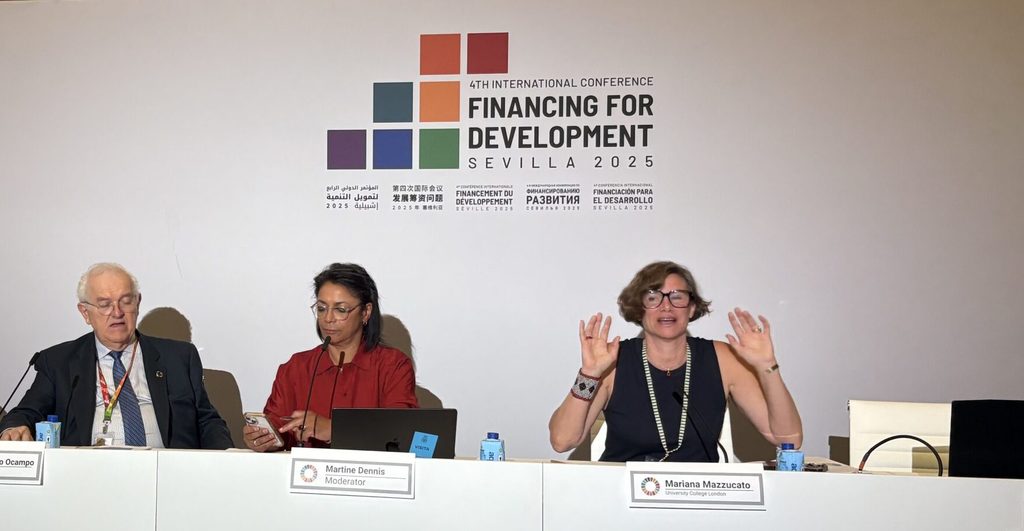The FfD4 offered many reminders of how far the global development finance architecture has shifted in the last decade. One of the clearest takeaways was the quiet burial of the “billions to trillions” narrative — the once-ubiquitous slogan that aid could and would catalyse vast volumes of private investment to achieve the Sustainable Development Goals (SDGs).
When launched at the Addis Ababa FfD3 Conference in 2015, “billions to trillions” captured an alluring proposition: scarce official development assistance (ODA) — in the low hundreds of billions — could be leveraged to unlock private capital flows measured in the trillions. Development would no longer depend on aid, but on mobilising global financial markets. They were heady times. A decade on, however, the record is sobering.
At Seville, panel after panel underscored the point that despite years of innovation in blended finance, guarantees and de-risking mechanisms, the volumes mobilised from private sources have been modest at best. OECD Development Assistance Committee figures show that from 2017 to 2023, private finance mobilised by official interventions averaged less than $55 billion per year — a fraction of the trillions originally envisaged.
Moreover, the flows have been highly concentrated. Middle-income countries with bankable infrastructure projects have absorbed most of the available private financing. Meanwhile, fragile states and low-income countries have seen little benefit.
Only six per cent of ODA-mobilised private finance was invested in least-developed countries in 2020, a figure that has remained stable for the past three years.
The reasons are both structural and political. Private investors tend to make decisions largely focused on risk and return.
If a country is perceived as politically unstable, has weak institutions or high corruption risks, investors will avoid it — even if concessional public funds are offered to “de-risk” the deal. While the idea was that small amounts of cheap public money could catalyse much larger private flows, in practice these subsidies have not been enough to shift investor behaviour at scale, with just US$0.37 of private capital leveraged for every dollar spent in low-income countries.
This failure is not just technical but political. The billions to trillions narrative reflected the widespread belief in the past two decades that markets, if properly de-risked, could deliver global public goods.
It implied that aid’s role was transitional — an enabler or catalyst that would stick around until private finance took over. For donors, the narrative was convenient: it promised exponential returns on shrinking aid budgets. For recipient governments, it offered a vision of abundant capital without the conditionalities of traditional ODA.
But, in practice, debt vulnerabilities deepened as governments borrowed on increasingly expensive terms, only to find foreign direct investment out of reach and private flows volatile or non-existent.
The much-touted promise of catalytic leverage has too often meant that governments assume contingent liabilities — through guarantees, concessional tranches or first-loss instruments — while private investors capture the upside. In effect, risks are socialised and rewards privatised, leaving the public sector exposed if projects fail.
At FfD4, this reality was laid bare. Speaker after speaker acknowledged that mobilisation ratios had been oversold, expectations inflated and accountability lacking. Broadly agreeing on that point, many speakers got on with the job of working out what to do next. Three shifts were especially evident.
First, a rebalancing toward domestic resources. Many delegations emphasised that private capital mobilisation cannot substitute for strengthening domestic tax systems, tackling illicit flows and building sovereign fiscal capacity. The rhetoric of “catalysing trillions” is giving way to the language of “maximising what is ours.”
Second, a more selective approach to private finance. Rather than chasing volume, development actors are beginning to focus on where private investment is genuinely additive — in renewable energy, digital infrastructure, sustainable agriculture and small to medium enterprise finance.
Drawing on her recent publication, Mind the Mission, not the Gap, the economist Mariana Mazzucato spoke of reframing blended finance not as a tool for filling gaps but as a mission-oriented instrument embedded within broader public-purpose strategies.
Rather than targeting financial leverage alone, she emphasises the need to shape markets intentionally — prioritising “directionality,” ensuring true additionality (where investments would otherwise not happen), fair sharing of risk and reward and transparency and governance mechanisms aligned with public goals.
She urged a shift from “market-fixing” to “market-shaping,” where public finance plays an enabling role in transformational development outcomes — not just de-risking ventures, but actively directing them toward structural and sustainable value.
Third, the rise of alternative models. Across the conference, references to Global Public Investment (GPI), the proposed Borrowers’ Forum, and South-South financial cooperation underscored a widening search for approaches beyond the previous orthodoxy.
Instead of viewing private capital as the inevitable driver of development, there is growing recognition of the role of concessional resources, cooperative financing arrangements and regional mechanisms — as well as governments themselves — in enabling the achievement and maintenance of public goods.
The demise of the billions to trillions frame should not be read as a wholesale rejection of private sector engagement.
Rather, it reflects a more sober assessment of its limits and a rethinking of expectations. Private capital is an essential component of sustainable development, but it is not a panacea.
If FfD3 in Addis Ababa was about exuberant aspiration, FfD4 in Seville was about pragmatic realism.
Rather than leverage ratios, the emphasis was on structural reforms: international tax cooperation, sovereign debt restructuring, adaptive climate finance and public investment in global goods. The private sector remains a partner, but no longer the imagined saviour.
As UN Deputy Secretary-General Amina Mohammed has argued, the task is to align finance with sustainable development objectives — not just set abstract targets — an emphasis she reiterated in Seville’s outcome framing.
This is the third article in the four-part Beyond aid: new directions in development finance series on the key debates at the Fourth International Conference on Financing for Development (FfD4), which was held in Seville, Spain in June 2025.
Disclosure: This series is based on research funded by the Asia Foundation.
This article appeared first on Devpolicy Blog (devpolicy.org), from the Development Policy Centre at The Australian National University.
n NICOLA NIXON is senior director, Governance, at The Asia Foundation, based in Hanoi. She is a visiting fellow of the School of Regulation and Global Governance at The Australian National University.
n MANDAKINI D. SURIE is an international development practitioner and consultant with program design, development, aid and grant management experience in South Asia. She has previously worked with DFAT, The Asia Foundation, UNDP and the Commonwealth Human Rights Initiative.
n OJASHWI K C works as program officer at the Asia Foundation, supporting governance programs across Asia and the Pacific and is based in Nepal. The views expressed in this article belong to the authors and do not necessarily reflect the views of this newspaper.




